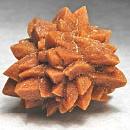|
|
||||||||||||||||
|
||||||||||||||||
|
||||||
|
|
|
|
Glendonite
(variety
of Calcite)
|
|
| | |
| First reported in 1905; IMA status: Not Valid (variety name) | ||
|
| ||
|
Chemistry |
|
|
| |
|
CaCO3 | |
|
|
Calcium Carbonate |
|
|
|
|
More Information |
|
|
|
|
|
|
Glendonitte
is a variety of Calcite. |
|
Synonyms: |
Fundylite, Gennoishi, Gersternkorner, Jarrowite, The "melting mineral", Molekryds, Pseudogaylussite, Rose Rock, Thinolite, White Sea Hornlets. |
|
Type Locality: |
Glendon, New South Wales, Australia |
|
Year Discovered: |
First reported in 1905 |
|
View mineral photos: | |
|
More Information: |
Mindat.org
(Glendonite) |
|
|
|
When Ikaite is removed from its natural cold water environment, it rapidly disintegrates into anhydrous calcium carbonate and water, earning it the nickname "the melting mineral". The resulting pseudomorph of Calcite after Ikaite is called "Glendonite" after the location where it was first reported in 1905, Glendon, New South Wales, Australia. Ikaite is named for the type locality at the Ikka Fjord (formerly spelled Ika), Greenland. Glendonite's most well know form is a radial arrangement of brown, reddish-brown or cinnamon-brown crystals. It has also been called the "rose rock" referring to the radial arrangement of the crystals giving it a flower-like appearance. Some have said the "spikey" habit of the crystals looks more like a pine cone. Calcite psuedomorphs after Ikaite are known by several other names as well. These names are often after specific locations such as Jarrowite named after Jarrow, Northumberland, UK, and Fundylite named for the Bay of Fundy, Nova Scotia, Canada. Other names are regionally derived referring to the crystal's unusual shapes such as Gersternkorner which is German for barleycorn and Gennoishi which is hammerstones in Japanese and Molekryds meaning mole cross in Danish. There are also the names White Sea Hornlets from the White Sea and Kola Peninsula, Russia and Thinolite from the Greek word thinos, meaning shore, from of the occurance in the tufa of Mono Lake, California, USA. Glendonite
distribution: in addition to the "type locality"
at Glendon, New South Wales (NSW), Australia, Glendonite
is also found at these locations in Australia: Hunter
Valley, Durham County, NSW; Wallaby Gully, Quarrobolong,
Northumberland County, NSW and Yerila Creek, North Flinders
Ranges, South Australia. In Canada at Eureka, Ellesmere Island, Nunavut Territory.
In Japan at Koudo, Ueda City, Nagano prefecture, Chubu region, Honshu Island.
In Russia at the Olenitsa River, White Sea Coast, Kola Peninsula, Murmanskaja Oblast', Northern Region.
In the USA at Mono Lake, Mono County, California; and
in Washington at Altoona, Wahkiakum County, and Five Mile Quarry, Porter, Grays Harbor County.
|
|
We
have not photographed our Glendonite
gems yet. Please
check back soon. |
